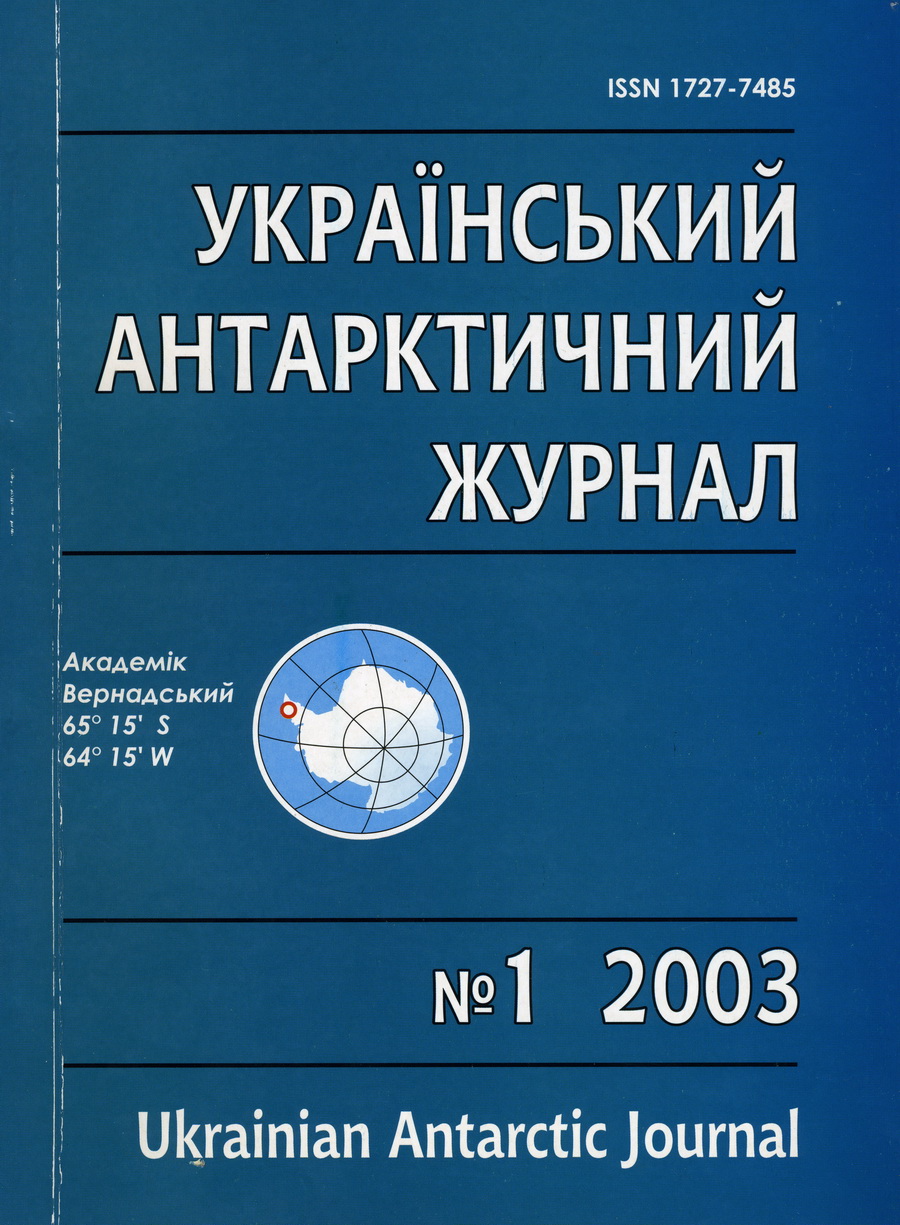Microplankton (phyto- and bacterioplankton) during austral autumn in the coastal waters of the Argentina Islands Archipelago, Antarctica
- phytoplankton,
- bacterioplankton,
- biomass,
- production,
- Antarctica
Abstract
Biomass and production of the bacterio- and phytoplankton were measured in the region of the Ukrainian Antarctic station Akademik Vernadsky at the end of March, 1998. There were marked 70 taxons of planktonic algaes in the composition of the "autumnal" phytoplankton in the Argentina islands archipelago waters. Biomass dominated were Bacillariophyceae, and the first of all, Corethron criophylum. Flagellates were most abundantly at the half of stations; the diatom algaes (Chaetoceros, Corethron, Fragilariopsis) were numerous and, at some stations, Coccolitophoridаe, as well. Measured primary production in the surface waters, on the average, was 9,66 ± 6,87 mg C m-3 day-1 (from 3,0 up to 15,86), and counted primary production – 7,55 ± 2,61 mg C m-3 day-1 (from 1,14 up to 12,61). The mean number of bacterioplankton was at the level of 0,5 million cells ml-1. Contribution of bacterial production in the surface layer was, on the average, 52 % of the primary production of phytoplankton.
References
- Bondar', S.B., & Orlova, I.G. (1998). K voprosu ob organizacii i otdel'nye rezul'taty kompleksnogo ekologicheskogo monitoringa v raione antarkticheskoi stancii Akademik Vernadskii [To the problem of organisation of, and selected results obtained in, comprehensive ecological monitoring in the region of the Antarctic station Akademik Vernadskiy]. Bulleten UAC, 2, 160-170. (In Russian)
- Brianceva, Yu.V. (1996). K metodike rascheta obyoma kletok fitoplanktona [To the method of calculation of the volume of phytoplankton cells]. Trudy YugNIRO, 42, 195-199. (In Russian)
- Ivanov, A.I., & Minicheva, G.G. (1998). Planktonnyie i bentosnyie vodorosli raiona ukrainskoi antarkticheskoi stancii Akademik Vernadskiy [Plankton and benthos algae of the region of the Ukrainian Antarctic Station Akademik Vernadsky]. Bulleten UAC, 2, 198-203. (In Russian)
- Rat'kova, T.N. Raspredeleniie fitoplanktona v Avstralo-novozelandskom sektore Antarktiki v ianvare-fevrale 1976 i 1983 [The distribution of phytoplankton in the Australo-New Zeland sector of Antarctica in January-February 1976 and 1983]. Biologiia okeana, tez. dokl. III cyezda sovietskih okeanologov. Leningrad, 14-19 December 1987. Leningrad, Gidrometeoizdat. pp. 53-55. (In Russian)
- Hailov, K.M. et al. (1992). Funkcional'naia morfologiia morskih mnogokletochnyh vodorosley [Functional morphology of sea many-cell algae]. Kyiv, Naukova dumka. 280 p. (In Russian)
- Chmyr, V.D., & Seregin, S.A. (2002). Produkcia bakterioplanktona v vodah Antarktiki v marte - aprele 1998 g. [Production of bacterioplankton in the Antarctic waters in March - April 1998]. Bulleten UAC, 3, 110-114. (In Russian)
- Aristegui, J., Montero, M.F., Ballesteros, S. et al. (1996). Planktonic primary production and microbial respiration measured by 14C assimilation and dissolved oxygen changes in coastal waters of the Antarctic Peninsula during austral summer: implications for carbon flux studies. MEPS, 132, 191-201.
- Basterretxea, G., & Aristegui, J. (1999). Phytoplankton biomass and production during late austral spring (1991) and summer (1993) in the Bransfield Strait. Polar Biology, 21, 11-22.
- Bj∅rnsen, P.K., & Kuparinen, J. (1991). Determination of bacterioplankton biomass, net production and growth efficiency in the Southern Ocean. Mar. Ecol. Prog. Ser., 71, 185-194.
- Bird, D.F., & Karl, D.M. (1999). Uncoupling of bacteria and phytoplankton during the austral spring bloom in Gerlache Strait, Antarctic Peninsua. Aquat. Microb. Ecol., 19, 13-27.
- Daneri, G., Iriarte, A., Garcia, V.M. et al. (1992). Growth irradiance as a factor controlling the dark respirations of marine phytoplankton. J. Mar. Biol. Ass. UK, 72, 723-726.
- Fuhrman, J.A., & Azam, F. (1980). Bacterioplankton secondary production estimates for coastal waters of British Columbia, Antarctica and California. Appl. Environ. Microbiol., 39, 1085-1095.
- Holm-Hansen, O., & Mitchell, B.G. (1991). Spatial and temporal distribution of phytoplankton and primary production in the western Bransfield Strait region. Deep Sea Res., 38, 961-980.
- Huntley, M., Karl, D.M., Niiler, P. et al. (1991). Research on Antarctic Coastal Ecosystem Rates (RACER): an interdisciplinary field experiment. Deep Sea Res., 38, 911-941.
- Karl, D.M., Holm-Hansen, O., Taylor, G.T. et al. (1991). Microbial biomass and productivity in the western Bransfield Strait, Antarctica, during the 1986-87 austral winter. Deep Sea Res., 38, 1029-1055.
- Kopczynska, E.E. (1996). Annual study of phytoplankton in Admiralty Bay, King George Island, Antarctica. Polish Polar Research, 17(3-4), 151-164.
- Kottmeier, S.T., & Sullivan, C.W. (1987). Late winter primary production and bacterial production in sea ice and seawater west of the Antarctic Peninsula. Mar. Ecol. Prog. Ser., 36(3), 287-298.
- Menden-Deuer, S., & Lessard, E.J. (2000). Carbon to volume relationship for dinoflagellates, diatoms, and protist plankton. Limnol. Oceanogr., 45(3), 569-579.
- Moline, M.A., & Pruzelin, B.B. (1996). High-resolution time-series data for 1991/1992 primary production and related parameters at a Palmer LTER coastal site: implications for modeling carbon fixation in the Southern Ocean. Polar Biology, 17(1), 39-53.
- Montagnes, D.J.S., & Franklin, D.J. (2001). Effect of temperature on diatom volume, growth rate, and carbon and nitrogen content: Reconsidering some paradigms. Limnol. Oceanogr., 46(8), 2008-2001.
- Steemann Nielsen, E. (1952). The use of radio-active carbon (14C) for measuring organic production in the sea. Journ. du Conseil, 18, 117-140.

